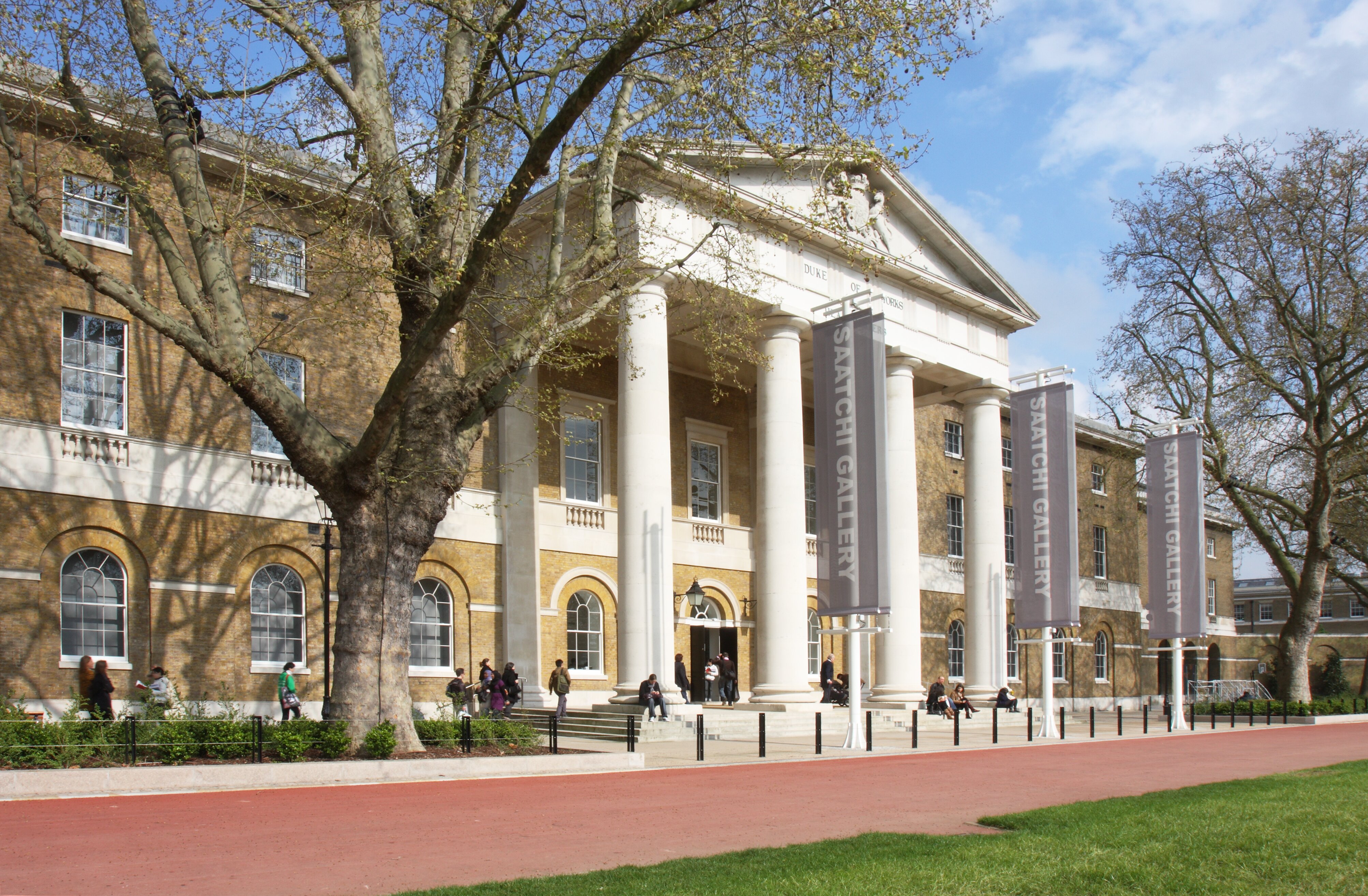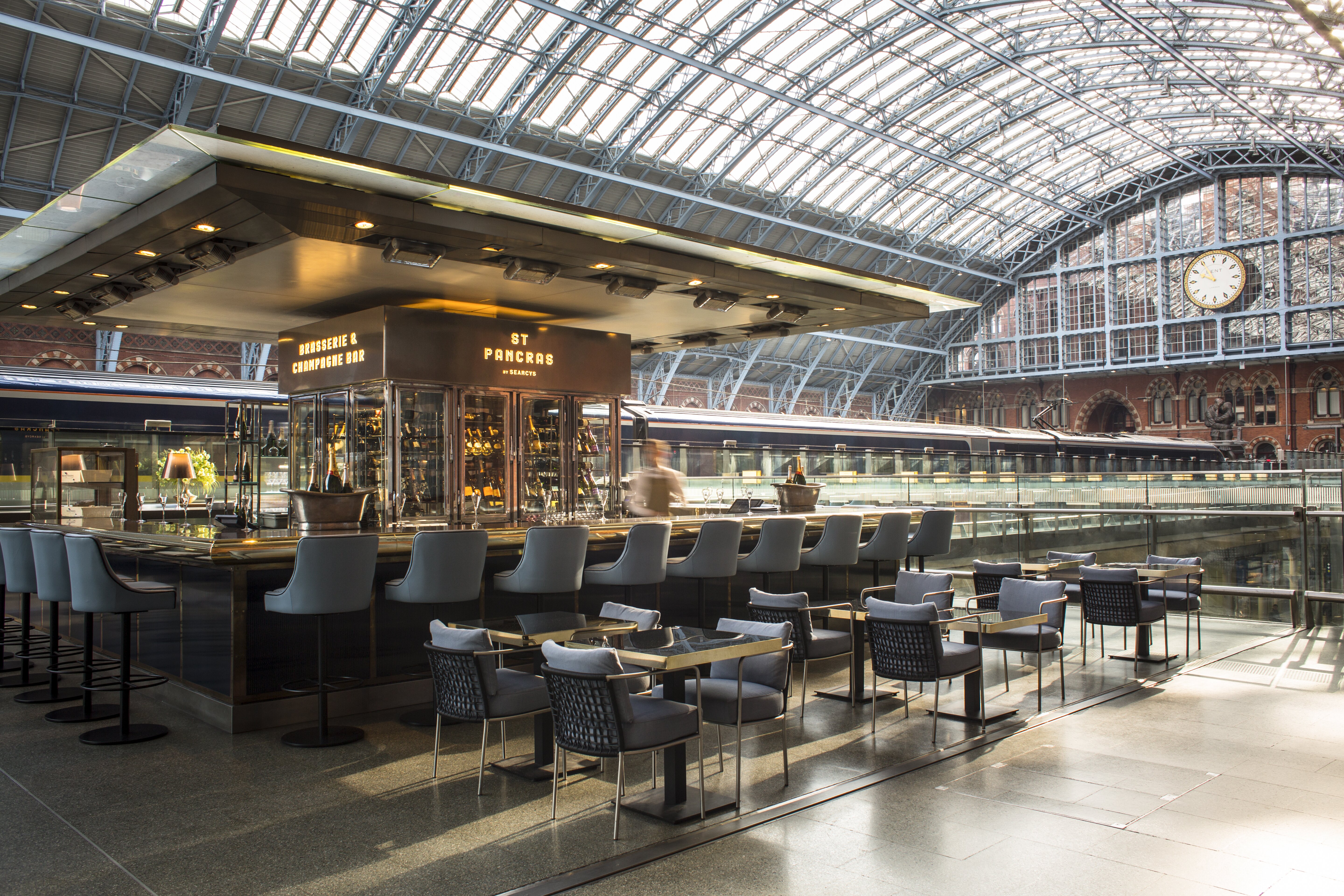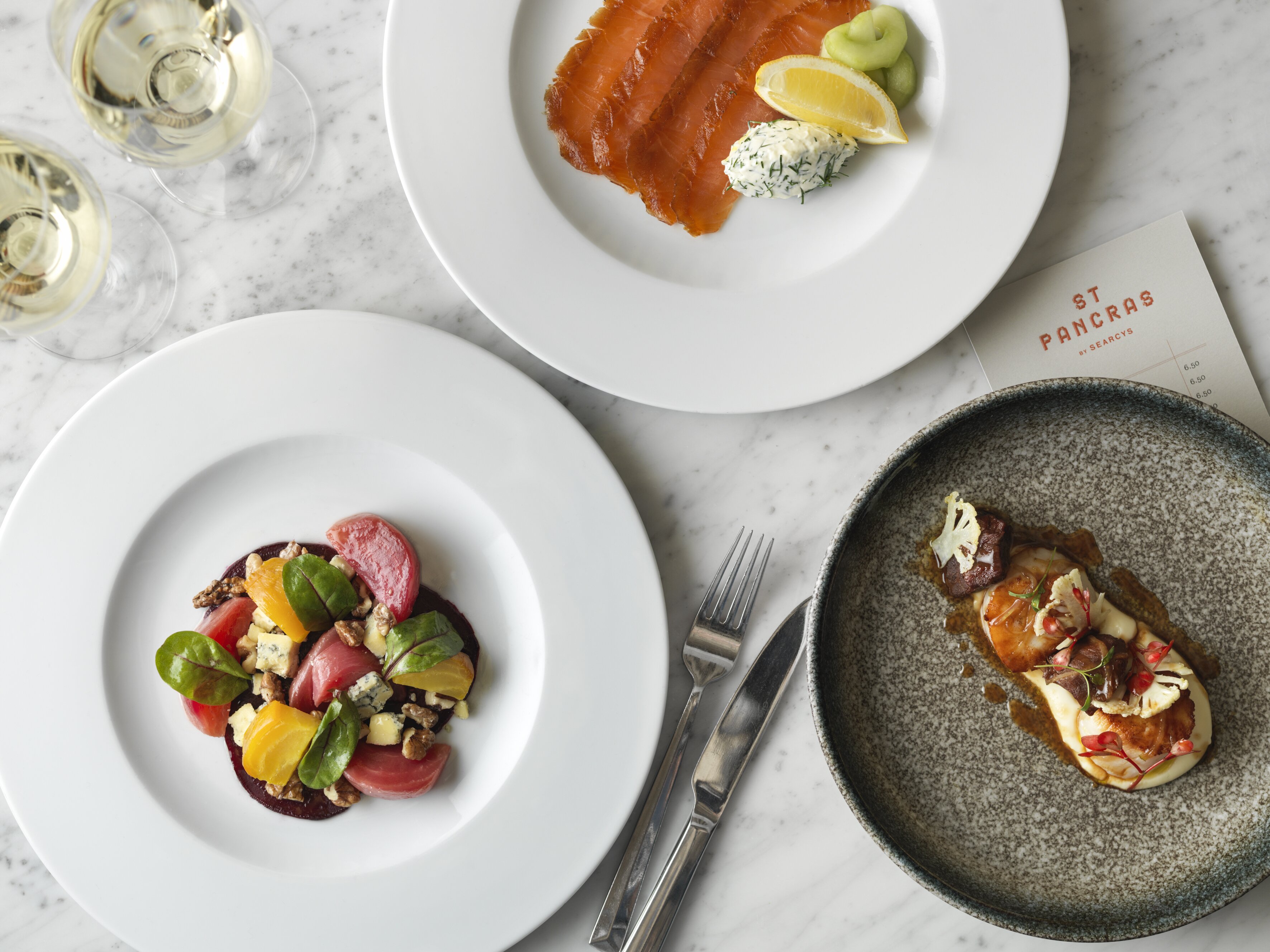How WSH are making the most of their acquisition of the Searcy's brand
WSH’s acquisition of Searcys in 2014 marked a pivotal moment for the Champagne brand. Turnover has increased by half, with 300 more employees and two extra sites added in 2020. But the figures only tell half the story. Janie Manzoori-Stamford finds out how managing director Matt Thomas is building for the future
“Are we excited about Saatchi? Yes we are. It’s a blinding opportunity,” says Matt Thomas, managing director of Searcys. The restaurant and event catering business has just launched the Saatchi Gallery Brasserie and Bar by Searcys, taking over from long-term incumbent restaurant operator Rhubarb. Hot on the heels of a successful pop-up café that Searcys has been running at the art gallery as part of the ‘Tutankhamun: Treasures of the Golden Pharaoh’ exhibition since November, it features the company’s third dedicated Champagne bar in London.

It also follows on from a string of new wins and launches, including the Honourable Artillery Company and HQS Wellington in London, Weston Park in Shropshire and Alnwick Garden in Northumberland in 2019, and the Royal Institution in Mayfair in 2020.
Alnwick Garden is an especially meaningful appointment for the business, because founder John Searcy was a pastry chef and confectioner for the third Duke of Northumberland prior to launching his eponymous company in 1847.
Of course, any operation that’s been going for 173 years will have undoubtedly seen the bells of change rung on more than one occasion. So how has Searcys evolved since it was bought by WSH in 2014? And what does the future look like for this enduring enterprise?
Acquisition and elevation
WSH acquires businesses where it can add value, says Thomas, and when you look at the numbers that aim certainly holds weight.
Searcys was bought for an undisclosed sum in August 2014, some 10 months after it was put on the market with a price tag of £25m-£30m. Annual turnover was reported to be £42.6m for the year ended 30 June 2014, with 20 sites and 1,082 employees on the books.
Fast forward to today and Searcys has seen its annual turnover increase to £60m. The number of staff, including casual, has risen to 1,400 and the number of sites is now 22, with many featuring multiple operations in one location.
The brief that WSH chairman and chief executive Alastair Storey gave Thomas when he was named managing director in 2017 was simple: do what you like to add value, just make sure you keep the name.
“We did a deep dive on who and what we are as a brand,” says Thomas. “We learned very quickly that we are a mature, British brand and that the market was responding well to heritage brands. So we had a really simple philosophy based on quality and innovation. Pretty timeless, by all accounts.”
Searcys had developed a portfolio that had come to include retail in the form of restaurant, bars and cafés, and hospitality in the form of conferencing and events (C&E). It operates in three principal markets (historic houses; estates; C&E venues) and three secondary markets (business and industry, leasehold and pop-ups).
“We found that we had an incredibly loyal team that wanted to help us to be more successful,” says Thomas. “Naturally we lost some people along the way, but that wasn’t a disappointment or actually a surprise. We now have, including me, a 12-strong executive team with a common purpose to provide brilliant food, appropriate service, and to find multiple ways to add value.”
If successful in all three endeavours, he adds, Searcys will generate better sales either through the base estate or new business opportunities and, at the same time, improve its reputation.
Evolving the business hasn’t only been about growth. Sometimes it has involved saying goodbye to customers who were, according to Thomas, “culturally misaligned”. Were these difficult decisions to make? “Short term it was tough, because there are lots of metrics for business success. Turnover, profitability, reputational standing and TripAdvisor scores are the most obvious examples,” he says.
“But it’s helped our team because in some of the loss-making accounts, we were spending a disproportionate amount of management time on the wrong customers. So it’s really lifted the teams’ heads to be able to look at what’s important and where they could add the most value.”
Doing the right thing
The word “value” comes up again and again when Thomas talks about Searcys and parent company WSH. But what does he and the wider business mean by it? Quite a lot, it turns out, including sustainability, CSR, experiential hospitality and more.
“We have a duty of care to do the right thing by the people we work with and the planet that we live on,” says Thomas. That is why in 2017 Searcys introduced what has grown to be 24 pledges that are committed to across the business, such as sourcing 90% of its fruit and veg from the UK, adding carbon-neutral Drappier Champagne to its lists and using only Fairtrade-certified chocolate and cocoa.
It started working with Beyond Food in 2019 to support the charity’s efforts to help those at the risk of homelessness to gain employment. Searcys does this by hosting a charity supper, leading a Christmas fundraising campaign and – where possible – recruiting people who have completed the social enterprise’s training and development course.
Meanwhile, Thomas and his team have worked hard to develop hospitality concepts that embrace consumer demand for experiences and compelling narratives, rather than just food and drink. These include partnerships with chocolatier William Curley, who has been delivering masterclasses to Searcys teams for the last two years, and chefs Matt Tebbutt and Mark Hix, who have been brought in for special dinners at the likes of Blenheim Palace and the Roman Baths and Pump Room.
Champagne will also play a big part of the drive towards experiential hospitality. The company has historically had a strong voice in Champagne and Thomas has strived to make it shout louder and with more clarity. The list of product on offer has been refined and the company has launched a Champagne school that both educates staff and creates a fresh opportunity for the aforementioned customer experiences, while collaborations with three English sparkling wine providers help to celebrate Searcys’ British heritage “without being flag waving”.
“I like to think of it as being a heartbeat. It’s just there. It’s natural. It’s not spiteful or contentious,” says Thomas. “We have our heritage and storytelling opportunities, to which people are responding well. It’s important that any brand stays relevant otherwise it will die.
“And growth is really important because it creates opportunities. It also creates a real excitement and a winning spirit that is without question infective. I don’t think we’ll ever be cool, but I’d like to be contemporary and appropriate. I’d like us to be a brand for which people can dress up or dress down and always feel excited.”
Looking forward
So what does the future hold? When Searcys was subject to a management buyout in 2010, after three years as part of the Alternative Hotel Group, there was an ambition by then chief executive Doug Tetley to roll out the Champagne bar concept to further transport and retail hubs. For a while new sites did open, at places like One New Change, Westfield London and Paddington station.

But the Saatchi Gallery launch takes the Champagne bar portfolio up to three, after St Pancras and Westfield Stratford. So does Thomas spy an opportunity to revive that goal? “Do we see the Champagne model migrating into transport hubs? Yes. I think that perhaps some of the outgoing owners were less interested in signing off on capex. Where that’s the case it’s difficult to secure brilliant space,” he says.
“But we have capex now for the right type of thing. For the right opportunity we would be very interested in looking at it. In the last 18 months or so we’ve tendered for a couple of high-volume transport hubs.”
What’s clear is Thomas’ determination to get it right. Champagne plays a big part of the company’s events business because of its importance to what he describes as the “art of celebration” and Searcys sells around 45,000 bottles a year of its own branded selected cuvée alone. So it’s very important to him that if he promises a premium product or experience, Searcys delivers.
“If you try and get people in on the grounds of luxury but you don’t realise it’s very good, people will join you for a single occasion and leave aggrieved because you brought them into your venue under a false pretence,” he explains. As such, the macro objective going forward remains unchanged, he says. “We want to be brilliant and by being brilliant we want to provide exceptional service and food. We’re running a company awards ceremony and conference next month where we’re looking to celebrate exactly that.”
In addition, Thomas aims to maintain sustainable business growth. By this he means to retain existing customers – “if it’s falling out the bottom, whatever we put in the top is counterintuitive” – and to look at new opportunities both in Searcys’ core London market and further afield – possibly even internationally.
“There are pockets of opportunity throughout the UK, though we’ve got to think very carefully about how we service them. We would like to see national growth and we’re working on a couple of opportunities at the moment, both north and south of London,” he says. “I don’t think midterm that we would rule out international opportunities. But we’ve got to be absolutely convinced that the customer we’re selling to wants to buy our product.”
Vital statistics
- Operations 22 venues incorporating 13 restaurants/bars, five cafés and multiple events spaces
- Events (in 2019) 15,000
- Guests (in 2019) 305,600
- Staff 1,400 (including casual)
- Annual turnover for 2019 £60m (+17.5% total; +6.7% like-for-like)
- Key sites St Pancras By Searcys; Helix at the Gherkin; Treehouse at the Alnwick Garden; Design Museum; Blenheim Palace; Roman Baths & Pump Room; One Moorgate Place
Putting the fizz back into St Pancras
St Pancras by Searcys opened as the company’s first dedicated Champagne bar in 2010 and remains the largest in the group. But by 2017, sales were “regressing quite significantly”, says Thomas. “It was to do with the fact that our food offer wasn’t what the customer wanted. Our service was sloppy, our prices were high, we were no longer adding value and our space wasn’t right either.”
Yet this year, Thomas says, sales will be 50% higher than at the end of 2017. How was this remarkable turnaround achieved?
It began with the layout of the operation. It was reconfigured to have guests enter via the bar rather than straight into the restaurant, with better signposting between the two installed.
In addition the offer was revamped to meet the needs of the two most typical customers: those coming for an experience and those looking for speed and quality while getting from A to B via the station. The Champagne list underwent a major overhaul, too.
Thomas explains: “We had more than 100 different varieties, which created a multitude of issues. We were often running out of product owing to space restrictions and there was too much available by the glass. If you don’t have enough throughput, there’s an argument to say that the product goes off. The other thing was I didn’t think our list was very interesting.”
With direction from Searcys drinks ambassador Joel Claustre, the list was refined and divided into five categories: house, featuring Searcys’ own select cuvée and its carbon-neutral Champagne from producer Drappier; grand marques; small growers; English sparkling; and world sparkling.

“It’s allowed us to crop our Champagne listings in that particular venue to about 30 different varieties,” says Thomas. “As a consequence it’s been easier to train our team in the differences between the brands and what makes each of them unique and to share this with the customer.”
















